Презентация observations focus groups
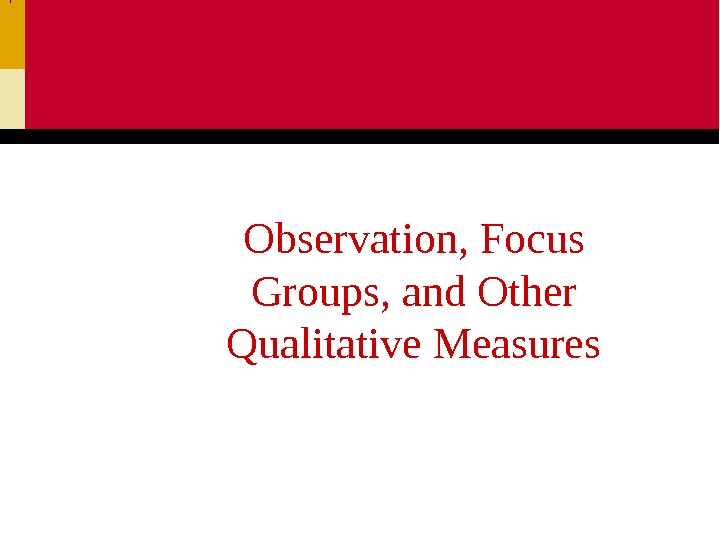
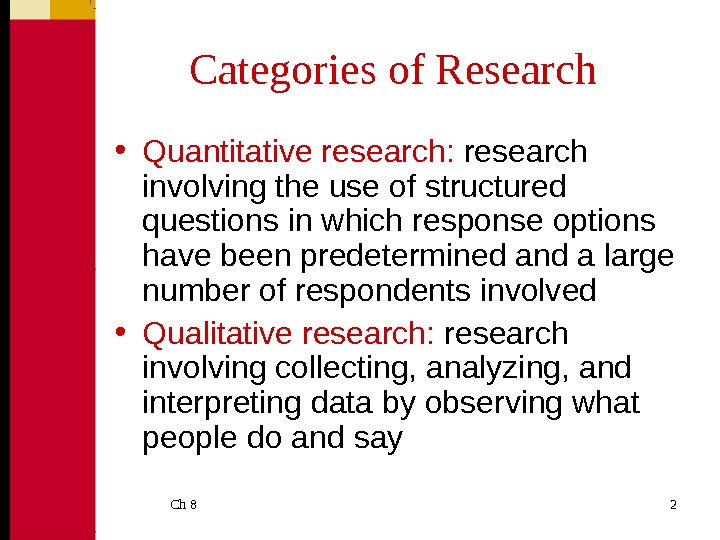
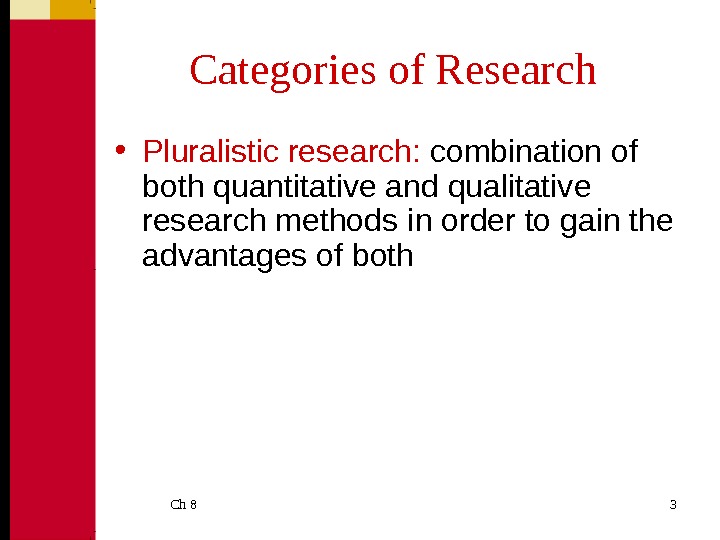





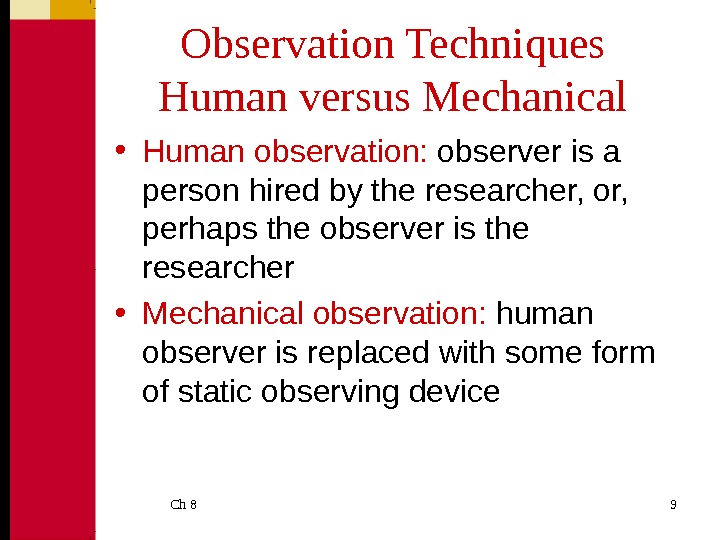
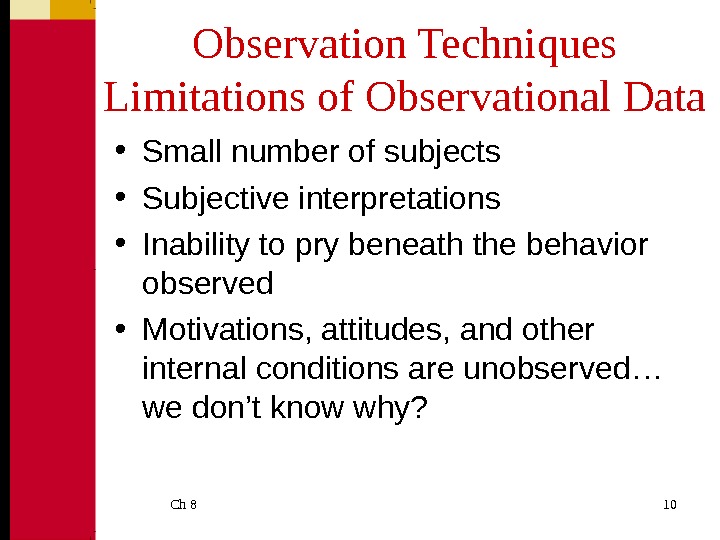


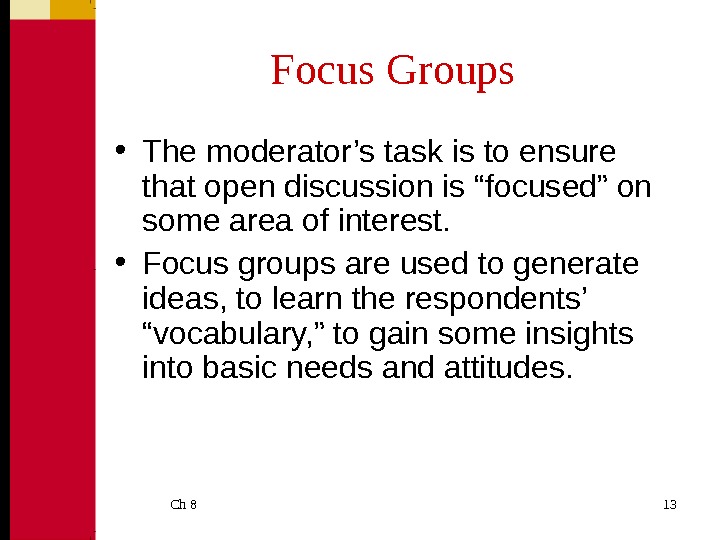

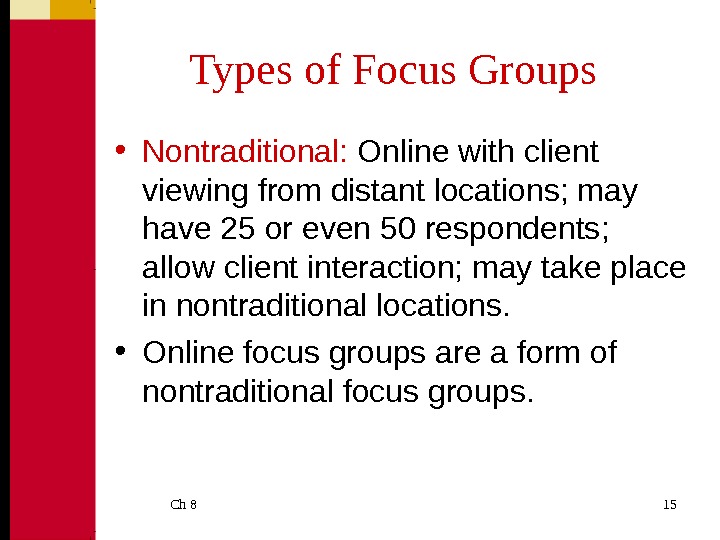
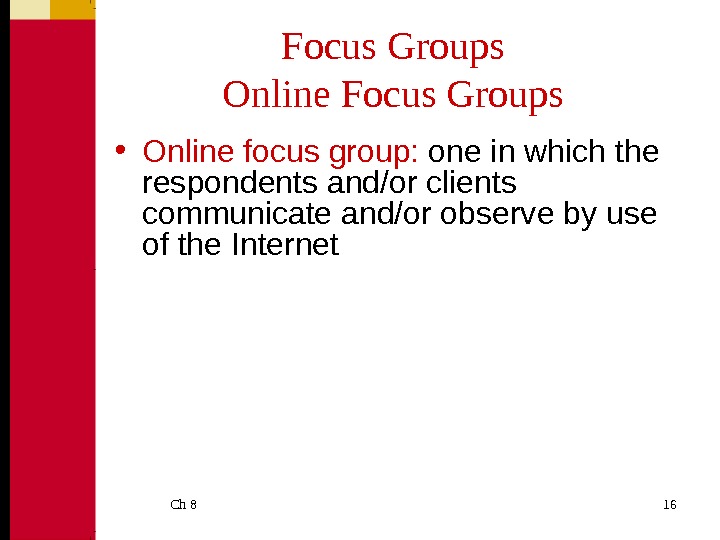
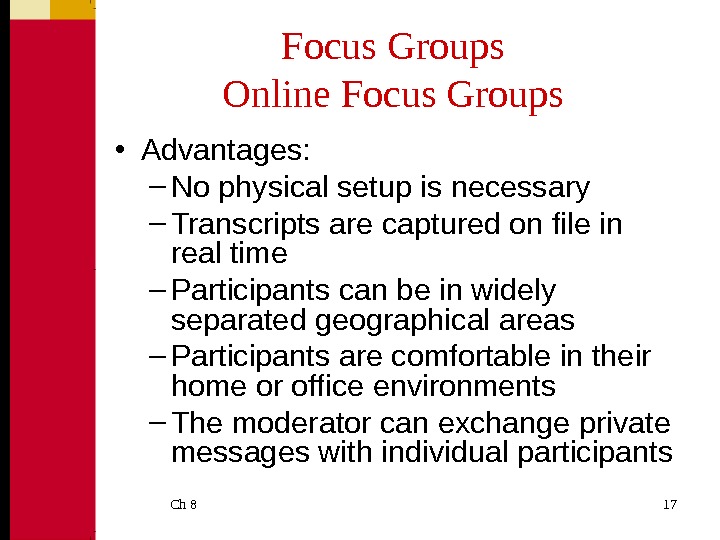


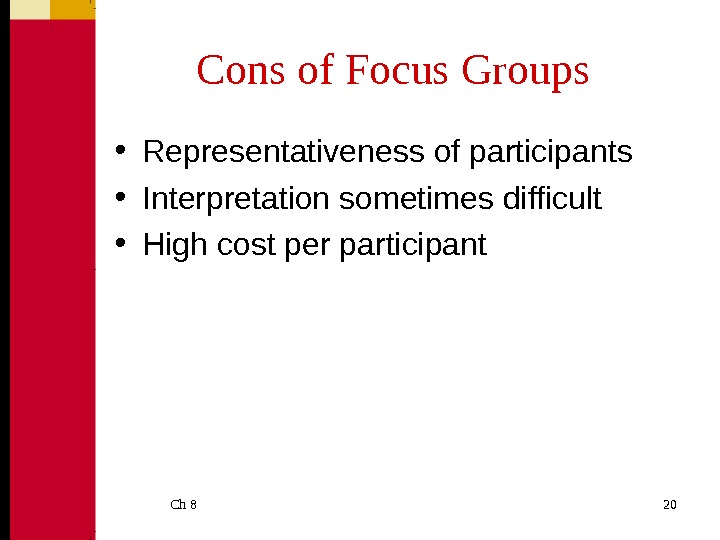
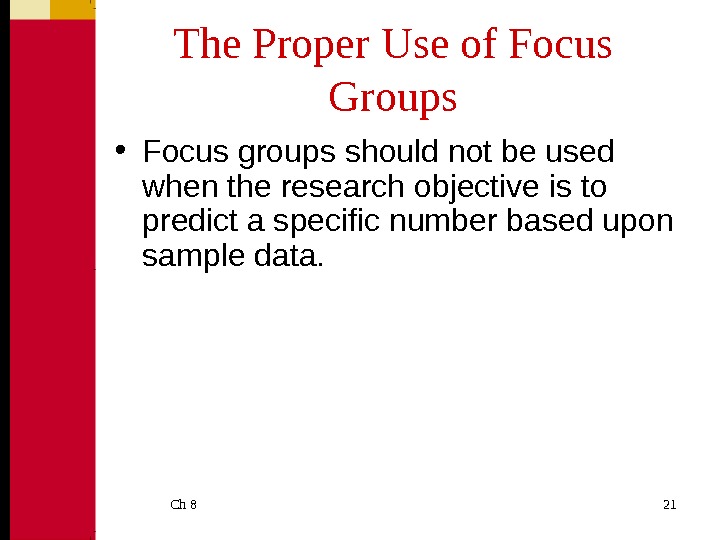




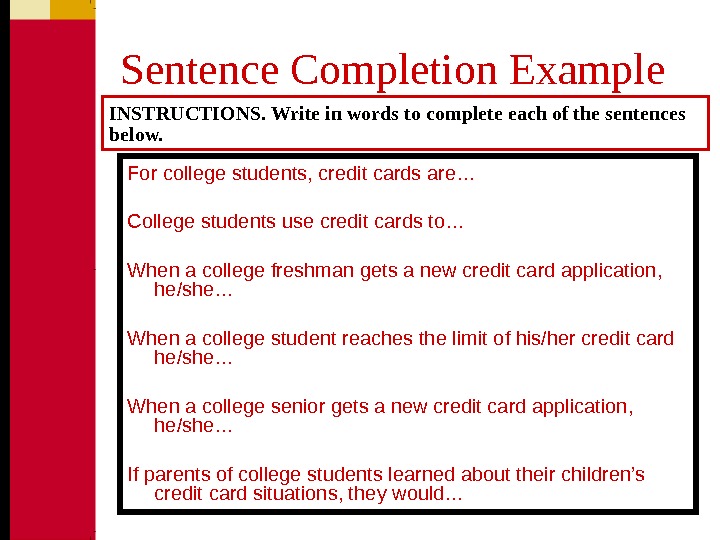

- Размер: 208 Кб
- Количество слайдов: 27
Описание презентации Презентация observations focus groups по слайдам
 Observation, Focus Groups, and Other Qualitative Measures
Observation, Focus Groups, and Other Qualitative Measures
 Ch 8 2 Categories of Research • Quantitative research: research involving the use of structured questions in which response options have been predetermined and a large number of respondents involved • Qualitative research: research involving collecting, analyzing, and interpreting data by observing what people do and say
Ch 8 2 Categories of Research • Quantitative research: research involving the use of structured questions in which response options have been predetermined and a large number of respondents involved • Qualitative research: research involving collecting, analyzing, and interpreting data by observing what people do and say
 Ch 8 3 Categories of Research • Pluralistic research: combination of both quantitative and qualitative research methods in order to gain the advantages of both
Ch 8 3 Categories of Research • Pluralistic research: combination of both quantitative and qualitative research methods in order to gain the advantages of both
 Ch 8 4 Observation Techniques • Observation methods: techniques in which the researcher relies on his or her powers of observation rather than communicating with a person in order to obtain information
Ch 8 4 Observation Techniques • Observation methods: techniques in which the researcher relies on his or her powers of observation rather than communicating with a person in order to obtain information
 Ch 8 5 Observation Techniques • Types of observation: – Direct versus indirect – Disguised versus undisguised – Structured versus unstructured – Human versus mechanical
Ch 8 5 Observation Techniques • Types of observation: – Direct versus indirect – Disguised versus undisguised – Structured versus unstructured – Human versus mechanical
 Ch 8 6 Observation Techniques Direct versus Indirect • Direct observation: observing behavior as it occurs • Indirect observation: observing the effects or results of the behavior rather than the behavior itself – Archives – Physical traces – Structured versus unstructured – Human versus mechanical
Ch 8 6 Observation Techniques Direct versus Indirect • Direct observation: observing behavior as it occurs • Indirect observation: observing the effects or results of the behavior rather than the behavior itself – Archives – Physical traces – Structured versus unstructured – Human versus mechanical
 Ch 8 7 Observation Techniques Disguised versus Undisguised • Disguised observation: subject is unaware that he or she is being observed • Undisguised observation: respondent is aware of observation
Ch 8 7 Observation Techniques Disguised versus Undisguised • Disguised observation: subject is unaware that he or she is being observed • Undisguised observation: respondent is aware of observation
 Ch 8 8 Observation Techniques Structured versus Unstructured • Structured observation: researcher identifies beforehand which behaviors are to be observed and recorded • Unstructured observation: no restriction is placed on what the observer would note: all behavior in the episode under study is monitored
Ch 8 8 Observation Techniques Structured versus Unstructured • Structured observation: researcher identifies beforehand which behaviors are to be observed and recorded • Unstructured observation: no restriction is placed on what the observer would note: all behavior in the episode under study is monitored
 Ch 8 9 Observation Techniques Human versus Mechanical • Human observation: observer is a person hired by the researcher, or, perhaps the observer is the researcher • Mechanical observation: human observer is replaced with some form of static observing device
Ch 8 9 Observation Techniques Human versus Mechanical • Human observation: observer is a person hired by the researcher, or, perhaps the observer is the researcher • Mechanical observation: human observer is replaced with some form of static observing device
 Ch 8 10 Observation Techniques Limitations of Observational Data • Small number of subjects • Subjective interpretations • Inability to pry beneath the behavior observed • Motivations, attitudes, and other internal conditions are unobserved… we don’t know why?
Ch 8 10 Observation Techniques Limitations of Observational Data • Small number of subjects • Subjective interpretations • Inability to pry beneath the behavior observed • Motivations, attitudes, and other internal conditions are unobserved… we don’t know why?
 Ch 8 11 Home Depot: An Example of Direct Observation Shopper/Store Use Profile Average time in store: 32. 4 (minutes) Customer party size: 1. 2 (persons) Average expenditures: 57. 34 (dollars) Payment method 73. 0% (credit card) Number of aisles traveled: 5. 7 Requests for assistance: 0. 5 Stops and looks at items 5. 4 Items handled per stop 2. 1 Total items handled 9. 3 Items purchased 2. 5 Product Categories of Purchases Appliances 10% Hand tools 22% Electrical 31% Plumbing 14% Roofing 3% Garden 35% Other 26%We know WHAT BUT, We don’t know WHY!
Ch 8 11 Home Depot: An Example of Direct Observation Shopper/Store Use Profile Average time in store: 32. 4 (minutes) Customer party size: 1. 2 (persons) Average expenditures: 57. 34 (dollars) Payment method 73. 0% (credit card) Number of aisles traveled: 5. 7 Requests for assistance: 0. 5 Stops and looks at items 5. 4 Items handled per stop 2. 1 Total items handled 9. 3 Items purchased 2. 5 Product Categories of Purchases Appliances 10% Hand tools 22% Electrical 31% Plumbing 14% Roofing 3% Garden 35% Other 26%We know WHAT BUT, We don’t know WHY!
 Ch 8 12 Focus Groups • Focus groups are small groups of people brought together and guided by a moderator through an unstructured, spontaneous discussion for the purpose of gaining information relevant to the research problem.
Ch 8 12 Focus Groups • Focus groups are small groups of people brought together and guided by a moderator through an unstructured, spontaneous discussion for the purpose of gaining information relevant to the research problem.
 Ch 8 13 Focus Groups • The moderator’s task is to ensure that open discussion is “focused” on some area of interest. • Focus groups are used to generate ideas, to learn the respondents’ “vocabulary, ” to gain some insights into basic needs and attitudes.
Ch 8 13 Focus Groups • The moderator’s task is to ensure that open discussion is “focused” on some area of interest. • Focus groups are used to generate ideas, to learn the respondents’ “vocabulary, ” to gain some insights into basic needs and attitudes.
 Ch 8 14 Types of Focus Groups • Traditional: Select 6 to 12 persons and meet in a dedicated room with one-way mirror for client viewing, for about two hours.
Ch 8 14 Types of Focus Groups • Traditional: Select 6 to 12 persons and meet in a dedicated room with one-way mirror for client viewing, for about two hours.
 Ch 8 15 Types of Focus Groups • Nontraditional: Online with client viewing from distant locations; may have 25 or even 50 respondents; allow client interaction; may take place in nontraditional locations. • Online focus groups are a form of nontraditional focus groups.
Ch 8 15 Types of Focus Groups • Nontraditional: Online with client viewing from distant locations; may have 25 or even 50 respondents; allow client interaction; may take place in nontraditional locations. • Online focus groups are a form of nontraditional focus groups.
 Ch 8 16 Focus Groups Online Focus Groups • Online focus group: one in which the respondents and/or clients communicate and/or observe by use of the Internet
Ch 8 16 Focus Groups Online Focus Groups • Online focus group: one in which the respondents and/or clients communicate and/or observe by use of the Internet
 Ch 8 17 Focus Groups Online Focus Groups • Advantages: – No physical setup is necessary – Transcripts are captured on file in real time – Participants can be in widely separated geographical areas – Participants are comfortable in their home or office environments – The moderator can exchange private messages with individual participants
Ch 8 17 Focus Groups Online Focus Groups • Advantages: – No physical setup is necessary – Transcripts are captured on file in real time – Participants can be in widely separated geographical areas – Participants are comfortable in their home or office environments – The moderator can exchange private messages with individual participants
 Ch 8 18 Focus Group Facility Floor Plan Source: Market Trends (www. markettrends. com)
Ch 8 18 Focus Group Facility Floor Plan Source: Market Trends (www. markettrends. com)
 Ch 8 19 Pros of Focus Groups • Generate fresh ideas • Allow clients to observe their participants • May be directed at understanding a wide variety of issues • Allow fairly easy access to special respondent groups
Ch 8 19 Pros of Focus Groups • Generate fresh ideas • Allow clients to observe their participants • May be directed at understanding a wide variety of issues • Allow fairly easy access to special respondent groups
 Ch 8 20 Cons of Focus Groups • Representativeness of participants • Interpretation sometimes difficult • High cost per participant
Ch 8 20 Cons of Focus Groups • Representativeness of participants • Interpretation sometimes difficult • High cost per participant
 Ch 8 21 The Proper Use of Focus Groups • Focus groups should not be used when the research objective is to predict a specific number based upon sample data.
Ch 8 21 The Proper Use of Focus Groups • Focus groups should not be used when the research objective is to predict a specific number based upon sample data.
 Ch 8 22 The Proper Use of Focus Groups • Focus groups should be used when the research objective is to describe rather than predict. – How do consumers describe a better package? – How would they describe their satisfaction with our service? – How could they describe their ideas for an ad campaign?
Ch 8 22 The Proper Use of Focus Groups • Focus groups should be used when the research objective is to describe rather than predict. – How do consumers describe a better package? – How would they describe their satisfaction with our service? – How could they describe their ideas for an ad campaign?
 Ch 8 23 Focus Groups Reporting and Use of Results • A focus group’s analysis should identify major themes as well as salient areas of disagreement among the participants
Ch 8 23 Focus Groups Reporting and Use of Results • A focus group’s analysis should identify major themes as well as salient areas of disagreement among the participants
 Ch 8 24 Other Qualitative Techniques • Depth interview is a set of probing questions posed one-on-one to a subject by a trained interviewer so as to gain an idea of what the subject thinks about something or why he or she behaves a certain way. • Protocol analysis involves placing a person in a decision-making situation and asking him or her to verbalize everything he or she considers when making a decision.
Ch 8 24 Other Qualitative Techniques • Depth interview is a set of probing questions posed one-on-one to a subject by a trained interviewer so as to gain an idea of what the subject thinks about something or why he or she behaves a certain way. • Protocol analysis involves placing a person in a decision-making situation and asking him or her to verbalize everything he or she considers when making a decision.
 Ch 8 25 Other Qualitative Techniques • Projective techniques involve situations in which participants are placed in (projected into) simulated activities in the hopes that they will divulge things about themselves that they might not reveal under direct questioning – Word association test – Sentence completion – Picture test – Cartoon test – Role-playing activity
Ch 8 25 Other Qualitative Techniques • Projective techniques involve situations in which participants are placed in (projected into) simulated activities in the hopes that they will divulge things about themselves that they might not reveal under direct questioning – Word association test – Sentence completion – Picture test – Cartoon test – Role-playing activity
 Ch 8 26 Sentence Completion Example INSTRUCTIONS. Write in words to complete each of the sentences below. For college students, credit cards are… College students use credit cards to… When a college freshman gets a new credit card application, he/she… When a college student reaches the limit of his/her credit card he/she… When a college senior gets a new credit card application, he/she… If parents of college students learned about their children’s credit card situations, they would…
Ch 8 26 Sentence Completion Example INSTRUCTIONS. Write in words to complete each of the sentences below. For college students, credit cards are… College students use credit cards to… When a college freshman gets a new credit card application, he/she… When a college student reaches the limit of his/her credit card he/she… When a college senior gets a new credit card application, he/she… If parents of college students learned about their children’s credit card situations, they would…
 Ch 8 27 Physiological Measurements • Physiological measurements: involves monitoring a respondent’s involuntary responses to marketing stimulus via the use of electrodes and other equipment – Pupilometer – Galvonometer
Ch 8 27 Physiological Measurements • Physiological measurements: involves monitoring a respondent’s involuntary responses to marketing stimulus via the use of electrodes and other equipment – Pupilometer – Galvonometer
